
Your virtual Italy vacation continues as Thor and I admire the magnificent statuary in Florence’s “public living room.”
NOTE: Since European travel is still tenuous with the pandemic continuing, I’m continuing my blog series offering a virtual vacation and time-travel to my first big trip with Thor in 2008. Italy! After starting with highlight photos posted here on Saturday, Jan. 30, I’ll now resume every week (after the blogging detour in real time to Hawaii). Join us in Rome, Florence, Cinque Terre, Venice, and Milan. Buon viaggio!
I was eager to follow in the footsteps of Miss Honeychurch in “A Room with a View,” as she gazed in astonishment at the heroic nude statues crowding this central piazza where locals and tourists alike promenade. (If you haven’t seen the film, go forth and do so — wonderful characters and British humor abound.) The expansive square fronts the Palazza Vecchio/Palazza della Signoria, the town hall of the city built in the 14th century. Its Loggia dei Lanzi, with three wide archways open to the square, houses an amazing collection of heroic-sized sculptures.

The piazza was also the central square of Forentia, a Roman town. When the piazza was repaved in the 1980s, evidence of the Romans was unearthed, including a huge basilica. Also discovered were Neolithic remains, so it’s been a popular place for a very long time. Ironically, in contrast to the celebration of Renaissance art here, it’s also the site of the Bonfire of the Vanities, where the rogue friar Giolamo Savonarola and his followers burned a huge pile of precious books, fripperies, and gaming tables in his campaign to purify corruption. Savonarola warned of apocalypse, ousted the ruling Medicis, and established a strict theocracy in Florence. Finally put on trial, he himself was hanged and burned here in 1498, on the spot memorialized by this plaque:
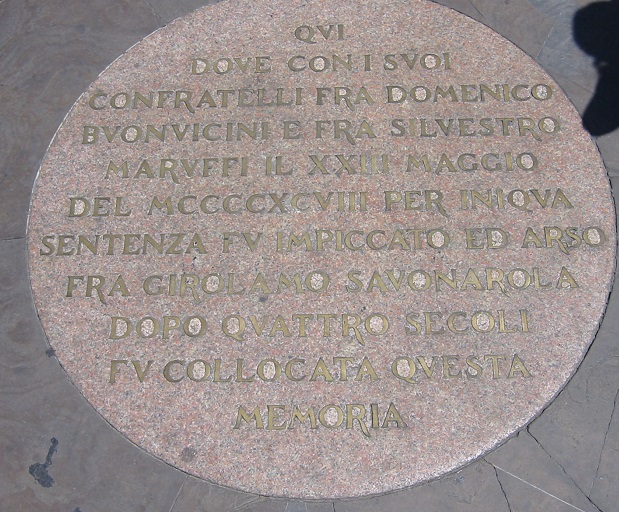
Some of the sculptures we admired in the Loggia:
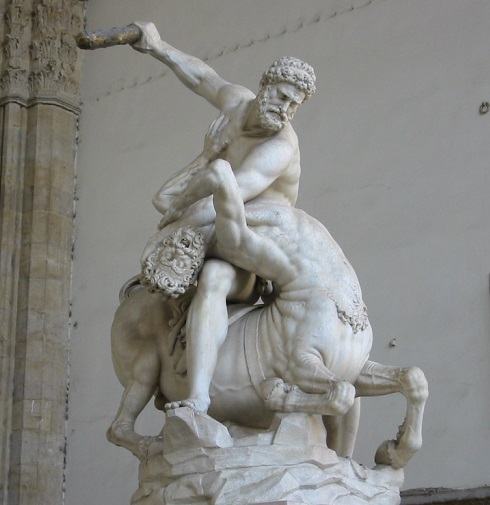
Hercules and the Centaur Nessus by Jean Giambologna was completed in 1599, carved from a single block of marble. Giambologna was greatly influenced by Michelangelo, and displayed a similar understanding of anatomy.
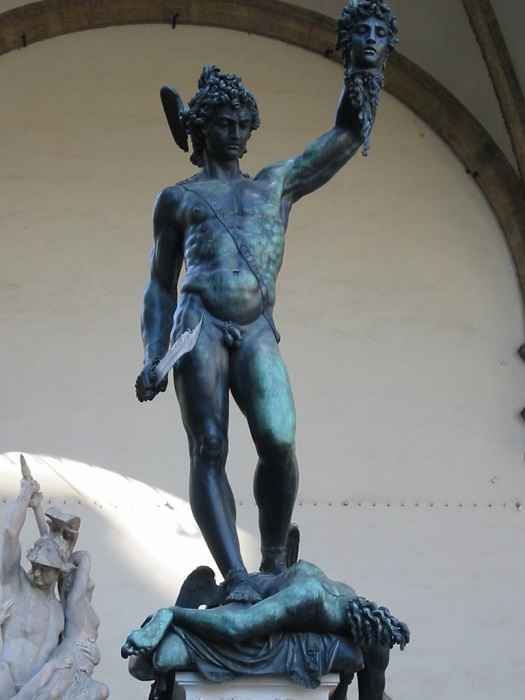
Perseus with the Head of Medusa, a bronze by Benvenuto Cellini completed between 1545 and 1554. Perseus received divine aid to defeat the dreaded, snake-haired Medusa, a single glimpse of whom would turn you to stone. The second Duke of Florence, Cosimo I de’ Medici, commissioned the work, apparently to warn his enemies of their fates if they opposed him.
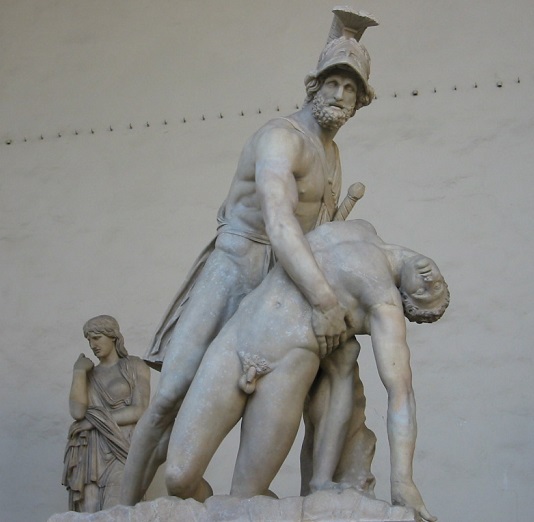
The Pasquino Group (also known as Ajax Carrying the Body of Achilles) copies a Hellenistic bronze original from around 200-150 B.C. There are many copies in Italy, and this one started with an ancient marble fragment acquired by Cosimo I. Several sculptors over the next few centuries tried to “restore” the fragment, and eventually Anton Raphael Megs and Stefano Ricci, from 1771 to 1830, created this marble sculpture to be erected in the loggia. There are some errors in “restoration,” including the seemingly dislocated shoulder of the Achilles figure.

The Rape (Abduction) of the Sabine Women by 16th century sculptor Giambologna, carved from a single block of marble, is considered his masterpiece. According to Roman history, in the mid 8th century BC the young city was lacking in women, so Romulus sent men out to scout for wives in surrounding regions. The Sabines refused to send their women to Rome, so many were abducted.
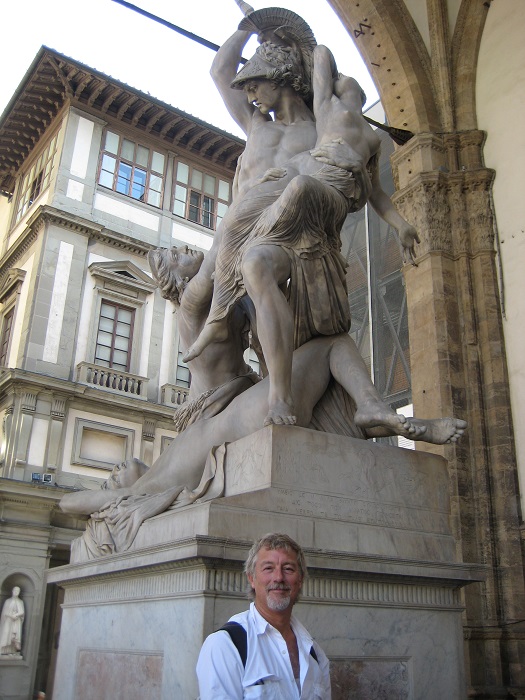
More abduction: The Rape of Polyxena, with Thor for size comparison (though he is rather heroically-sized himself). Sculpted from a single block of marble by Pio Fedi in 1865, it honored elements of Renaissance style as well as later Romantic and Baroque elements. Polyxena was the daughter of King Priam and Queen Hecuba of Troy, and Achilles fell in love with her. One version of the tale holds that she helped arrange his murder, and then Achilles’ ghost demanded Polyxena’s sacrifice on his tomb. In this sculpture, the Greeks are abducting her.
For contrast, a startling embellishment in the loggia:
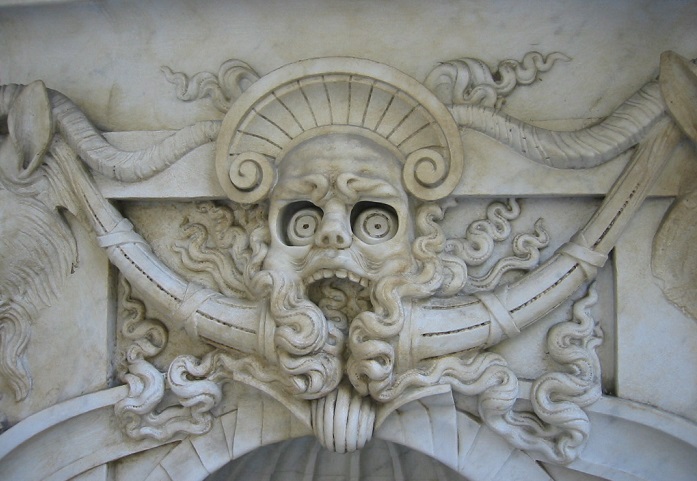
The Fountain of Neptune, a prominent feature of the piazza, near the bronze equestrian statue of Cosimo I, another work by Giambologna erected in 1594:
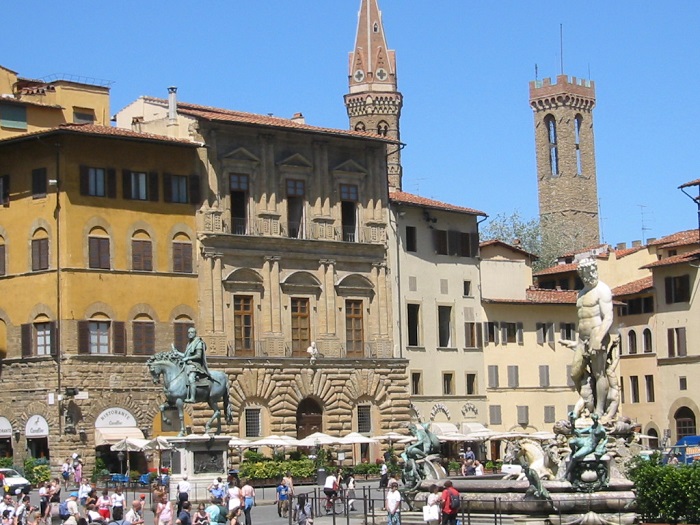
The Neptune fountain, derided by Michelangelo as a “waste of good marble,” was another work commissioned by Cosimo I de’ Medici, to celebrate the marriage of his son to Duchess Joanna of Austria. Designed by Baccio Bandinelli, it was produced by Bartolomeo Ammannati and his assistants between 1560 and 1574. It’s sort of a hodgepodge of mythic elements, with the giant statue of Neptune wearing Cosimo’s face and standing on a sea-shell chariot pulled by marble horses. Behind him is the heraldic lion of Florence, the Marzocco, this version a copy of one made by Donnatello from around 1418.
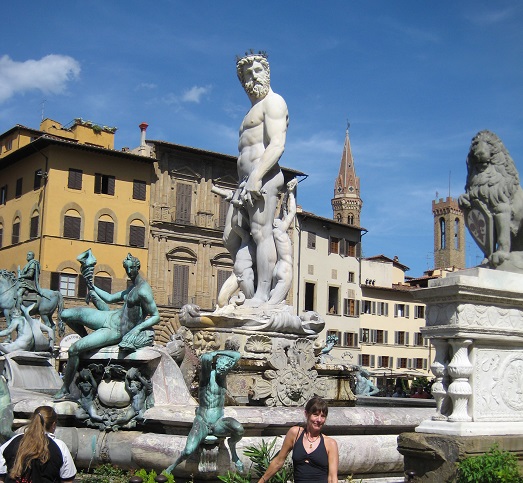
I confess a susceptibility to the rakish charms of satyrs….
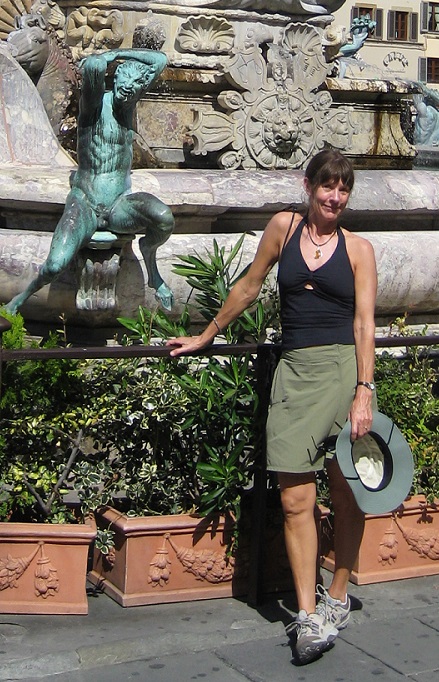
Next week: The imposing Cathedral of Santa Maria del Fiore and the Dome of Brunelleschi.

*****
You will find The Rambling Writer’s blog posts here every Saturday. Sara’s latest novel from Book View Cafe is available in print and ebook: The Ariadne Connection. It’s a near-future thriller set in the Greek islands. “Technology triggers a deadly new plague. Can a healer find the cure?” The novel has received the Chanticleer Global Thriller Grand Prize and the Cygnus Award for Speculative Fiction. Sara has recently returned from another research trip in Greece and is back at work on the sequel, The Ariadne Disconnect. Sign up for her quarterly email newsletter at www.sarastamey.com

1 thought on “The Rambling Writer’s Italy, part 13: Florence, Piazza della Signoria”